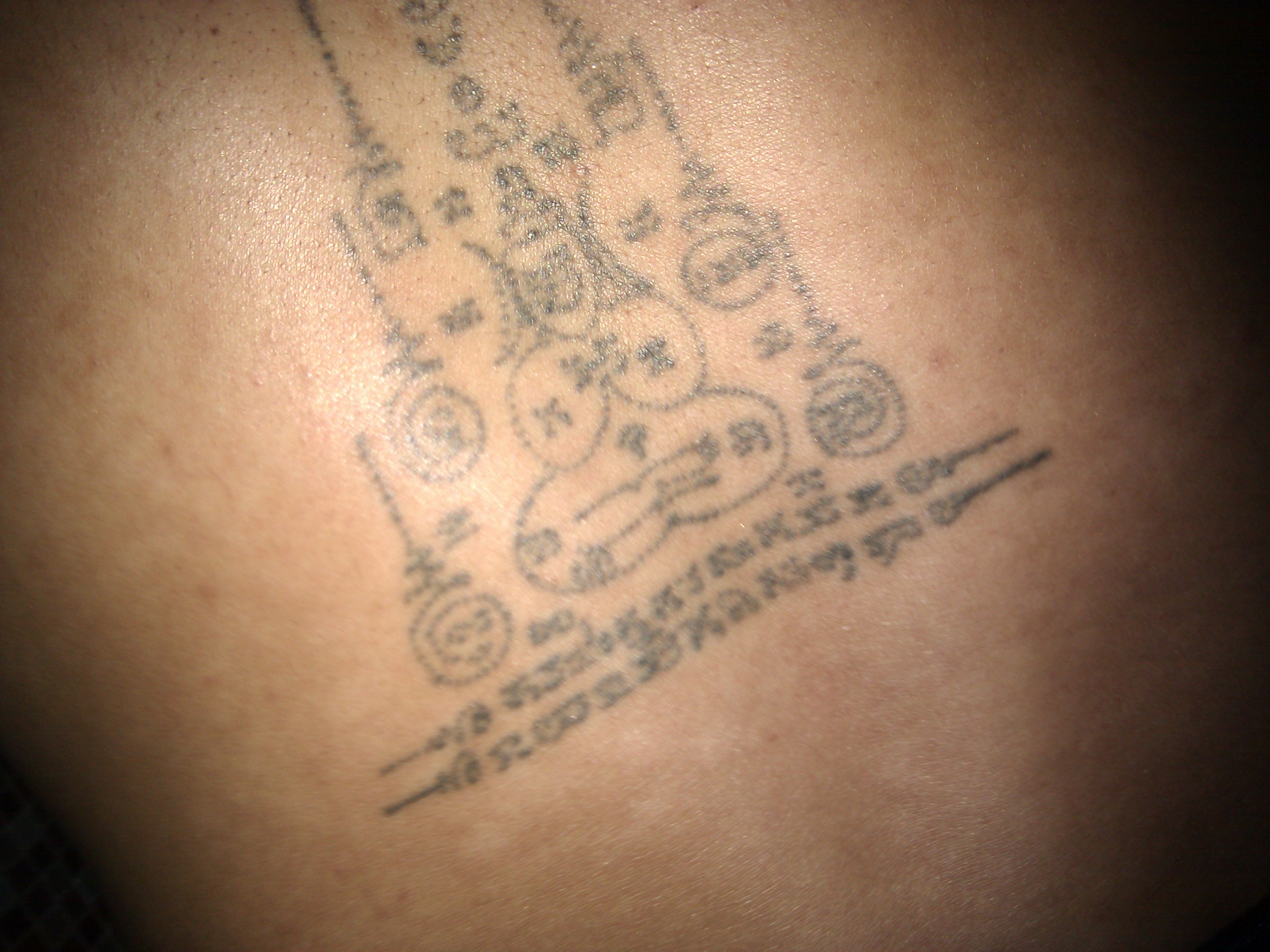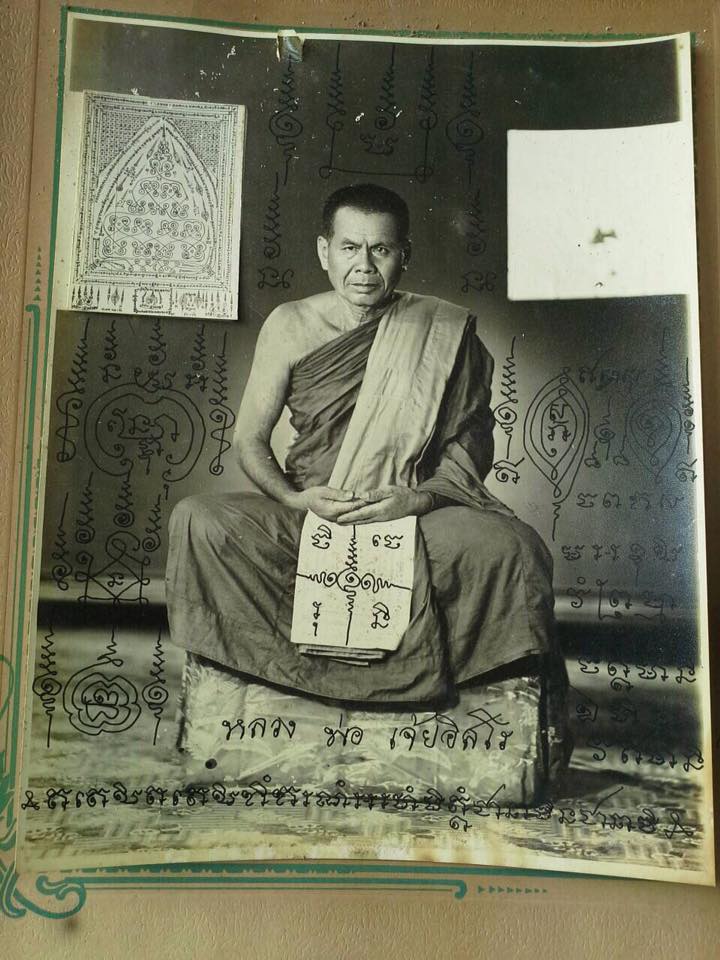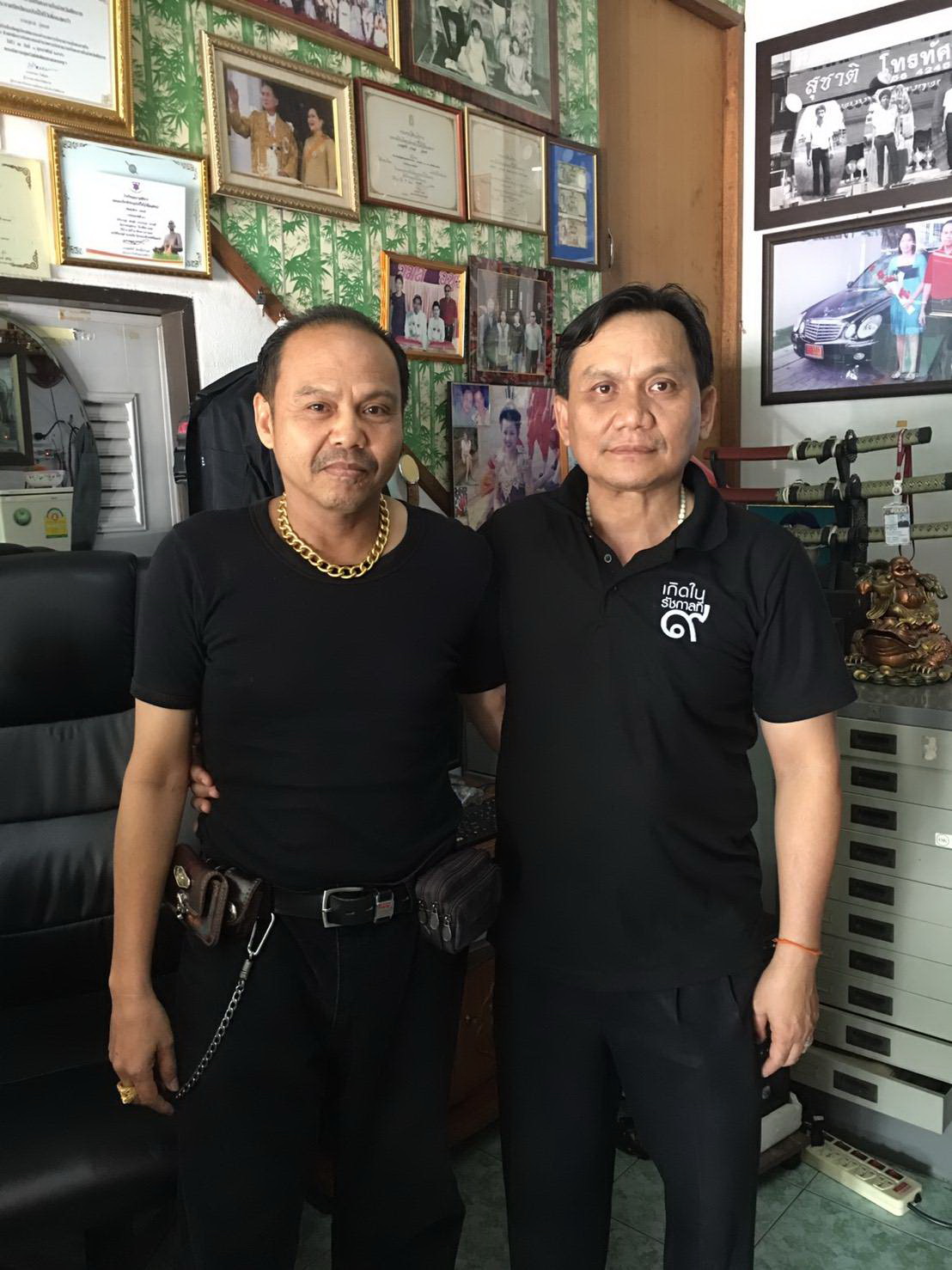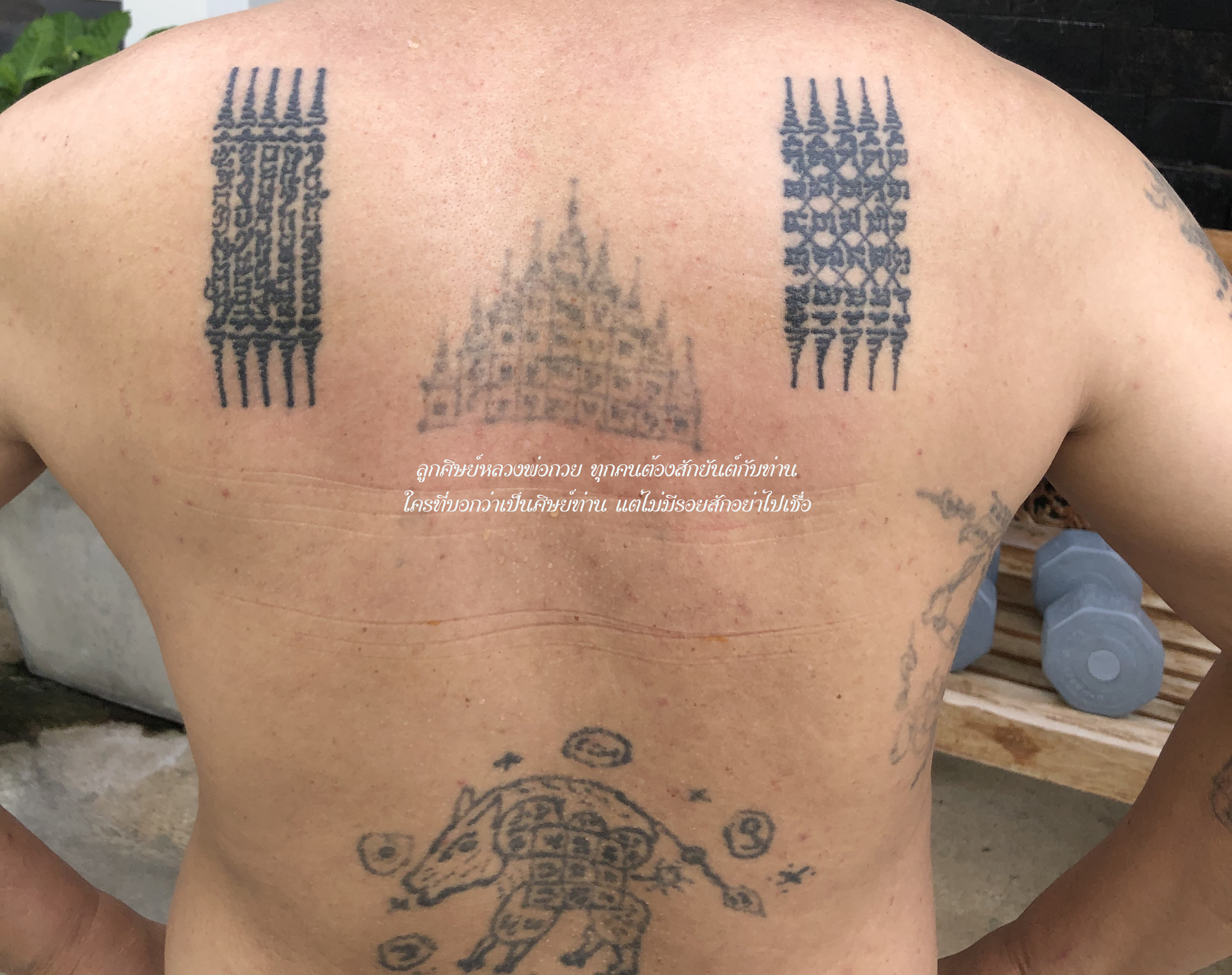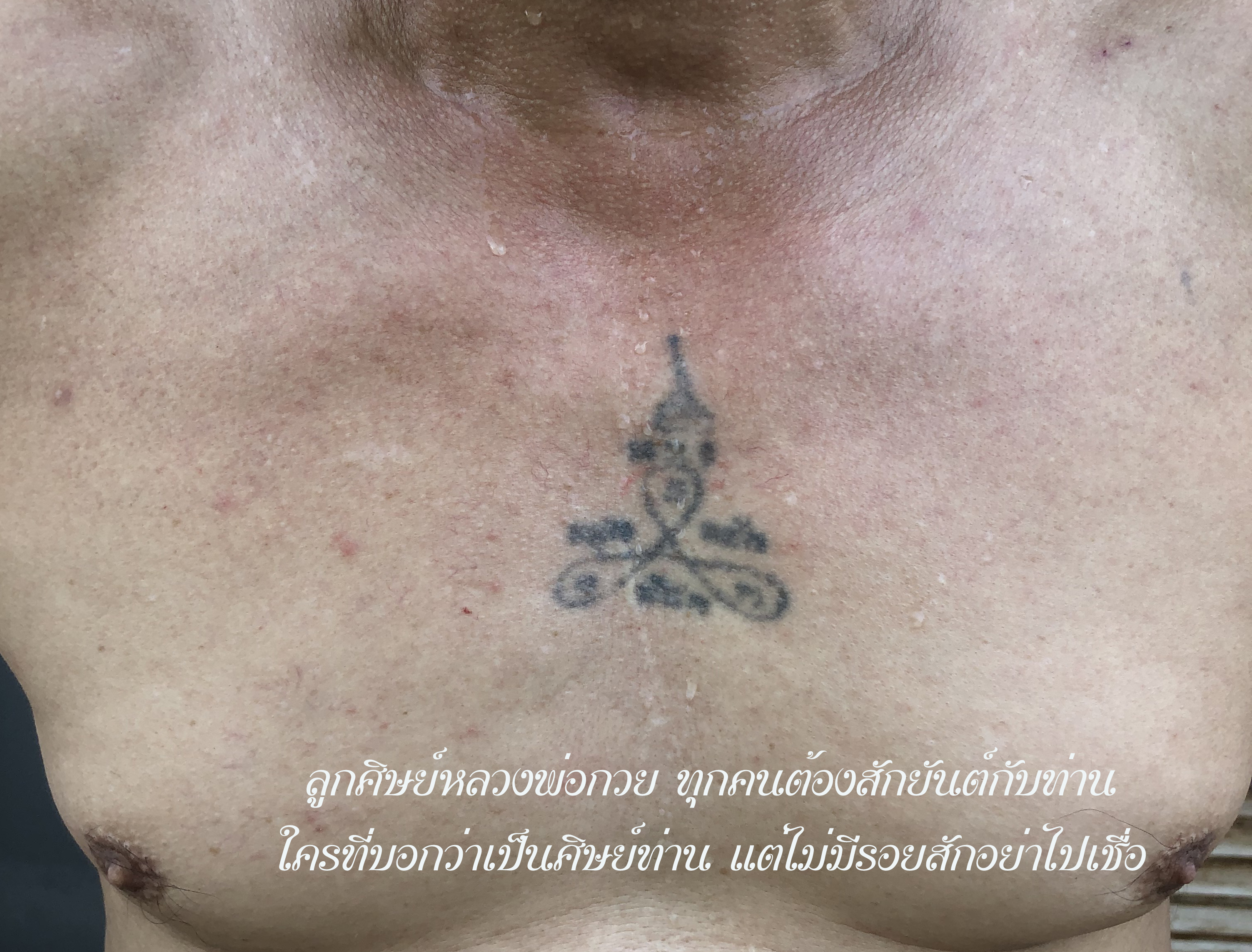หลวงพ่อเจ้ย
อิสสโร
(จอมโจรมเหศวร
ตัวจริง)ศิษย์พี่หลวงปู่กวย
ที่หลวงพ่อเดิมได้สั่งใว้ถ้าท่านมรณะให้ไปหาท่านเจ้ย
He would preach
about how if Nang
Matri had not
followed Pra
Duassandorn into the
forest. Then he
would have been a
spinster. He would
then preach about
spinsters, female
and male, and tell
how if this person
was left by his
wife, that he must
be intolerable, and
if a woman was
without husband, its
must be because this
or that. People who
were spinsters or
widows would not be
able to sit in the
Sala and listen, for
embarrassment, and
would have to go
hide behind a wall
or a tree to listen
to the sermon. It
became clear then,
that Luang Por Guay
did not have the art
of preaching very
polished. Some
people would even
break out in tears
listening to his
sermons about being
a lonely spinster.
The real reason why
he could not give
sermons using the
Vessantara jataka,
was that it is
necessary to use
quirkiness and humor
to tell the tale and
make parables. Luang
Por Guay did not
like to behave in
this manner. In
order to evade
further
embarassments, Luang
Por evaded preaching
by going to learn
traditional medicine
with Hmor Khian, who
was famous for being
able to suppress
plagues and
epidemics. In Koke
Chang village many
people were dying
from an epidemic,
and even all the
other doctors had
died.

Only Hmor Khian
remained who was
able to cure the
‘Roke Khai Torapis’
disease which was
quickly killing off
all the villagers.
On the 19th May
2472, Pra Guay began
to learn
Bpariyadtitam
(Theoretical
Dhamma), in order to
develop in his
understanding and
practice of the
Buddha Sasana,
studying at Wat Wang
Khorn for two years,
and then continuing
his studies to the
Doctorate degree.As
he was just about to
enter the exams for
his qualifications,
he became very ill,
and was unable to
continue. He then
decided that he had
studied enough, and
that he should now
focus on Vipassana
Kammathana practice
and Wicha Akom, and
received training in
how to make and
empower magic charms
and amulets,
effigies and
talismans.
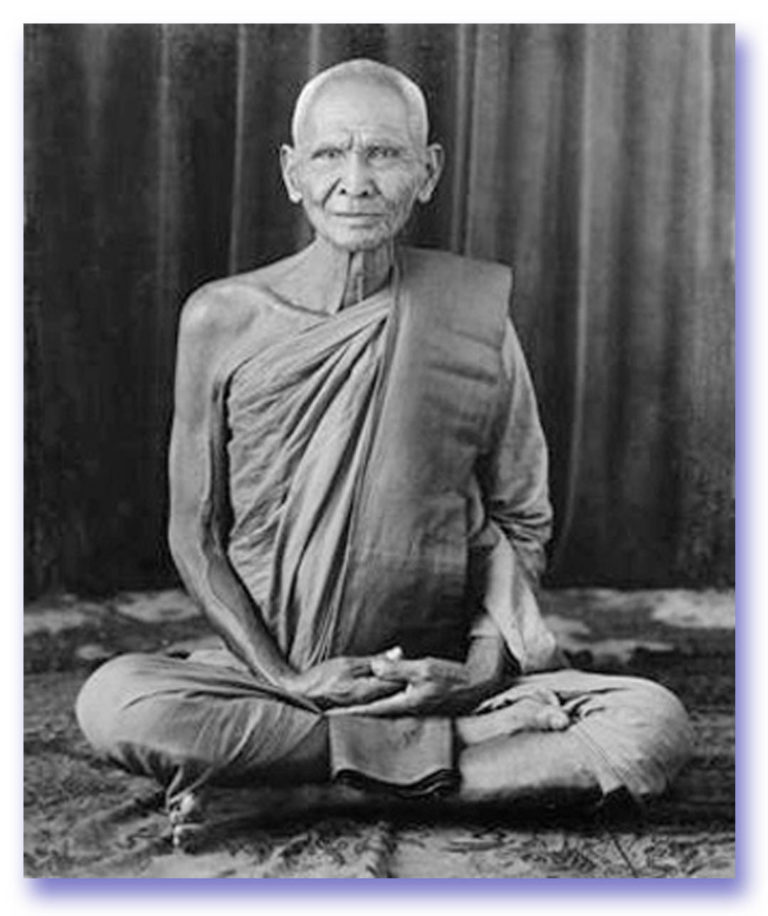
He traveled to learn
Wicha from Luang Por
Sri Wiriya Sopat of
Wat Prang
(Singhburi), who is
said to have been
the greatest
Vipassana Kammathana
Master of the region
at that time. It was
here that Luang Por
learned the Wicha of
making magic rings.
This is belief is
supported by the
fact that Luang Por
Sri Wiriyas magic
rings had the Khom
Letters ‘Idti’
inscribed, which are
also found to be
present on magic
rings from Luang Por
Guay. Luang por
continued to gather
Mastery in various
other magical Wicha
from Luang Por Sri
Wiriya. After this,
he traveled to stay
at Wat Nong Dta
Gaew, in Koke Chang,
Supannburi.He
planted a Samor tree
at this temple,
which can still be
seen standing there
where he planted it
to this day. Luang
Por Saman once went
to stay at Wat Nong
Dta Gaew, and took a
cockerel and placed
it in Luang Por
Guays tree (chickens
sleep in trees).
Apparently, the
Cockerel refused to
sleep all night in
this tree. Nobody
knows what kind of
Wicha Luang Por Guay
placed into the
tree, but for a
Cockerel to refuse
to sleep when it is
sitting in its most
natural sleeping
habitat, reveals
that there was
something unnatural
about Luang Por
Guays tree. Luang
Por Guays powers
must have developed
rapidly because at
the time he planted
the tree, he was
only 32 years old
and had been a Monk
for 8 years..This
shows that Luang Por
Guay had attained
Magical abilities at
a very young age
already. He stayed
at Wat Nong Dta Gaew
for one year, and
then traveled on to
Wat Nong Khaem in
Sakburi (Chainat
Province), where he
remained for a
period of one year.
Whilst he was there,
he learned
traditional medicine
with Yome Buan, a
Lay Master from Ban
Nong Khaem, and he
then continued his
studies with Hmor
Yai in Ban Bang Nam
Pra, close by to Ban
Nong Khaem.At Wat
Nong Khaem, there
was another Bhikkhu
befriended with
Luanbg Por Guay, by
the name of Jaem.
One day, Pra Jaem
found an ancient
‘Samut Khoi’
(Grimoire in Bai Lan
parchment leaf), as
he was wandering.
But he was not able
to bring the book,
because it had some
kind of protective
spell or Deity
watching over it. So
Pra Jaem invited
Luang Por Guay to
come and have a
look. Whjen they
arrived at the tree
stump where the book
was hidden, Luang
Por Guay saw that
Pra jaem had told
the truth, the
Grimoire was indeed
there. There were signs of someone having brought flowers, incense and candles to make Bucha with to the Grimoire and placed them beneath the tree stump. So Luang Por Guay lit the candles and the incense, and prayed;
If the Devas who protect this book wish me to take it and preserve the Wicha, then let this incense stick burn out completely”.
But the incense stick did not burn completely, so Luang por Guay began again and this time said;
“If you let me take
the Dtamra with me,
I promise I shall
only use it for the
benefit of the
temple and help all
Sentient Beings”.This time, all three of the incense sticks burned completely to the ground. Luang Por then performed ‘Gruad Nam’ (the pouring of water to dedicate the fruits of ones merits to the dead – a story covered in Buddha Magic Issue 3), and dedicated the fruits of his merits to the Master of this Dtamra he had discovered, and the Deities who protected it. He then performed the ceremony to invite the Grimoire to come with him to the temple.
There was a story circulating after this, that someone once took the Dtamra home with them and put it in their room, but the household experienced much disaster, sickness and even death, so the person had taken it and placed it under the tree stump.
When he heard the story, Luang Por Guay opened the book and began to read it, and he found a passage which mentioned that it was forbidden to take into anybodys house at all, if not, there would be great loss and misfortune. Luang Por Guay then began to learn the various Yant and Wicha, memorizing and practicing the magic spells within the ancient Grimoire.
This is where he got a great deal of his powerful Wicha from. The Grimoire is still there at the temple. The cover says ‘Kroo Raeng’ in red on it.
Few people have been lucky enough to open this Dtamra, but It was written from someone who has opened it, that the Grimoire contains hundreds of Yant and magic Kata.
One extremely powerful Kata within the Grimoire is the “Pramontr Pra Putta Jao Chana Marn” (Mantra of the Buddha Conquering Mara), which is a spell so powerful that it is forbidden for a layperson to recite. This Montr Kata has both ways to perform white magic and also harmful black magic.
These ancient manuscripts are now in the Kuti hut of Ajarn Samruay (abbot of Wat Nong Khaem). Most of the books are at the temple, on a ‘Pan’ (offerng tray) beside the Hmoo Dto Bucha of Luang Por Samruay.
A couple of the books are kept in other temples too;
One book is in posession of Ajarn Hwian Kontamtong in his Kuti at Wat Ta Tong (Supannburi), another is in the care of Ajarn Dtua, and one book with Ajarn Sawaeng at Wat Nong Iduk (Chainat).
When Luang Por Guay left Wat Nong Khaem, he travelled on and stopped at Wat Bang Dta Hngay (Nakorn Sawan). As he was residing here, he went to learn Wicha from Luang Por Derm of Wat Nong Po. He learned how to make magical armbands and rings, Tagrud, and Meed Hmor, as well as many other peripheral Wicha and spells. He also learned the Wicha of healing broken bones from Luang Por Kane of Wat Dong Sethee (Utay Thani).
It is also believed that Luang Por Guay assembled many other Wicha which he gathered from various Ajarn who are not documented. This is believed to be substantiated by some tell-tale hints, such as the fact that Luang Por Guay made a Pra Yord Khunpol amulet which had a monk coin from Luang Por Gan inserted in the rear face, which suggests that he may have learnt Wicha from LP Gan and thus used his lockets to inset in his own amulets, as a sign of respect toward and faith in his Kroo.
Famous Master Monk, Luang Phu Pimpa, once said of Luang Por Guay that ‘Pra Guay he understands Magic perfectly – before he went to the North to learn their Wicha, he didn’t have any more power than your average monk, but after he returned from learning the Lanna Wicha (referring to his stay in Nakorn Sawan), he kept himself to himself, and spoke little. When he did speak however, it was evident that LP Guays mind was elevated, and that he had a gift of speech’.
It is strongly believed that LP Guay really did receive Wicha from LP Derm, because a fotograph of LP Derm with LP Derms handwriting to LP Guay was found in his Kuti. A Looksit of LP Guay remembers also that just after the second world war, LP Guay went to ask LP Derm to teach him the Wicha Tam Tong and the Wicha of Len Prae Taat (minerals and crystals/elements etc), but that at that time, Luang Por Derm did not show him.
The next news of Luang Por Guay returning to Wat Ban Kae (Wat Kositaram)
was officially recorded in 2484, which was when he began to make Sak Yant on the Looksit of Wat Ban Kae (Wat Kositaram). Luang Por Guays Sak Yant became so legendary, because a large number of the local folk had experienced multiple cases of being shot at and the gun either not firing, or the bullets not penetrating the skin.
This made people flock to the temple for Sak Yant tattoos from the surrounding areas, and the temple was overflowed with people all day and night. In the end, as Luang Por retired from Sak yant, he once commented to a Looksit that if he didn’t stop tattooing, then he could take 100 Baht notes and use them to tile the roof of his Kuti with! (a weeks wages back then may have been not more than a couple of Baht).
On the 1st September 2491, Luang Por Guay was elected Abbot of Wat Ban Kae. Luang Por Guay saw that the folk of Ban Kae were very poor and many people did not have enough to eat, and thus took up the practice of only eating one meal a day instead of the two before midday which are normally allowed for a Maha Nikaya Buddhist monk, in support of the people and to consume less. He would help the poor and needy and heal the sick, give Buddha amulets to those who needed some confidence and something to help them fight on in life, and try his best to improve the life of local Folk in general.
He was very loved for this by the local Folk. Luang Por was not a monk who liked to build things or develop, he liked simplicity and stillness. Even his Kuti was old ‘Song Thai’ (Thai style wooden house), that he had given the temple lay committee and some Looksit the task of building it to save money, and only hired special craftsmen for the most difficult pieces of the building. The temple thus only had old rickety Kuti huts and no fancy buildings except for the Uposadha shrine room, the Kuti Chudtintaro (memorial Kuti hut for LP Guay), and the Sala Tam Bun building.
On the 5th December 2511, Luang Por Guay received the honor of status of ‘Pra Kroo Chan Pratuan’.
Luang Por Guay passed away, on the 12 April 2522 at the age of 75 years old. He passed on in peaceful recline. The year before he died, he fell ill, and was carried to Paya Tai hospital for examination. The examining Doctor concluded that Luang Por Guay was suffering from food deficiency since over 30 years, and gave him some protein supplements for a period of a whole month, which turned out to still not be enough for his physical needs.
But when Luang Por returned to the temple, he continued his habit of eating only one meal a day without paying attention to the warnings. It seemed that since his return from hospital though, that his casting of magic spells and empowerment of amulets had become even more effervescent and intense. He seemed very strong physically as far as outside appearances went. In the year 2522, Luang Por wrote down two notes in his calendar;
Pra Luang Por Guay marked the day he would become ill with blue pen, and the day he died was marked in red pen. The days were the 11th March, and the 11th April 2522 BE. Luang Por had written the Pra Kata Namo Dta Bord, and the words “I Pra Guay Na Dtandto Namo Dtandti Dtandti Dtandto Namo Dtan Dtan – will die on the 11th April
at 7:55”.
As the 11th came nearer, Luang Por Guay fell ill, but it was not possible to detect any fever or recognizable illness – he could not eat, and would even spit his rice out and refuse any more, instead grabbing a piece of Tagrud and inscribing spells. In the night he would hold the Sai Sincana cord and empower amulets. He would inscribe lottery numbers on the palm of his hand, and sometimes show to Looksit with Choke Lap who came to pay last respects. As the tenth arrived, everybody came to await his passing, but on the 11th he was still alive.
Some of the temple committee suggested that his Kuti was full of magic and even images of the Kroo, perhaps no Deities could enter to take him. So they moved Luang Por Guay to the chanting room, where he opened his eyes in farewell for the last time, placed his hands together, and then, something amazing happened; The temple bell fell down from where it was hanging, and crashed to the floor ringing out loud with a resounding echo. The Looksit then realised that Luang Por Guay had passed on in this moment, and tuned to look at the time. It was exactly 7:55 am on the 12th April.
The 12th of April every year is the date for paying reverence to Luang Por Guay at Wat Kositaram, where Looksit gather each year to pray to Luang Por Guay and ask for his blessings to continue to protect them and improve their lives.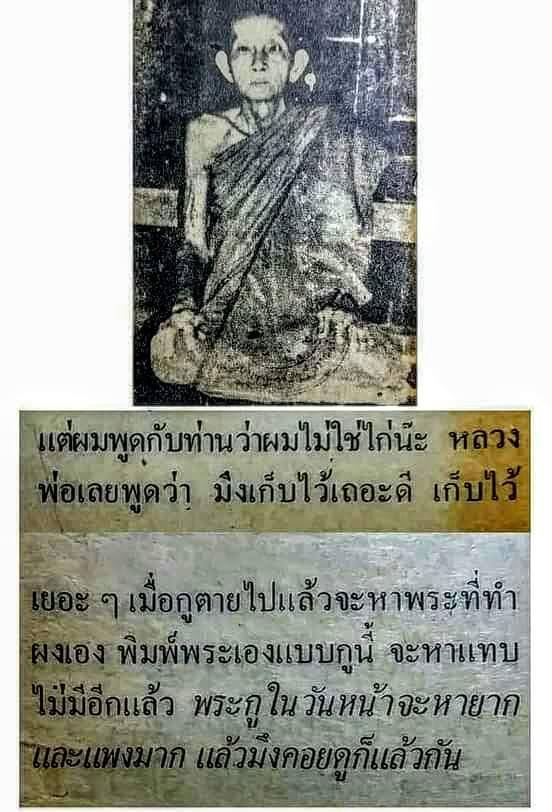
【推荐】长按图片保存,然后微信扫一扫,添加好友!
龙婆贵大师,生前最喜欢打坐修法,修得神通之力,能知未来,他也被称为:天书奇僧!并且,龙婆贵师父加持的自身像、崇迪、西瓦里等佛牌,都有很好的口碑和神迹。
下面,咱们分为:“(一)、关于龙婆贵大师;(二)、龙婆贵自身佛牌介绍;(三)、龙婆贵崇迪佛牌介绍;(四)、龙婆贵招财女神佛牌介绍;(五)、龙婆贵佛牌疑问解答:a、龙婆贵的什么牌比较好?b、龙婆贵自身为什么贵?c、龙婆贵那期自身最好?”共五个部份,来详细介绍:龙婆贵师父,以及他的佛牌。
一、关于龙婆贵大师:
龙婆贵大师,出生于:佛历2448年,圆寂于:佛历2522年,僧龄54年。龙婆贵大师,生前最喜欢打坐修法,修得神通之力,能知未来。同时,龙婆贵大师,也被称为:天书奇僧
龙婆贵大师,生于佛历2448年11月2号,出生在猜纳府里一个名叫邦奇的小村庄。大师有三个弟弟和一个妹妹,他是家里的老大。大师的父母都很疼爱他,在大师六岁的时候,父母就送他去瓦邦奇跟龙婆库学习佛法和法门,由于大师天资聪明,学习过的法门除了能过目不忘之外,而且还会使用法术。
龙婆库大师预知龙婆贵:将来一定成为一个很有名的高僧。在龙婆库大师园寂之后,龙婆贵就去瓦华登跟阿赞独学习其他法门。龙婆贵大师,去学校读过书,但读了两年之后就停学了,因为要回乡下帮助父母的农业。龙婆贵大师对父母说:如果要他要出家当和尚的话,他一定不会再还俗了。
佛历2467年7月5号,在龙婆贵大师20岁的时候,大师在瓦博出家当了和尚,由当时的戒师:龙婆帕和阿赞灵,负责龙婆贵的出家仪式,大师被赐予:Chutinataro的法号。这个法号有着很好的意思,就是说这个世界充满了七情六欲,
如果他希望可以修成正果,他一定要放下所有的七情六欲。
龙婆贵传奇事迹1:
在佛历2477年6月1日的时候,龙婆贵大师在一个机缘下,找到了一本命名为:Kru
Rang的古老的圣书。当时,龙婆贵大师在瓦农刊里,学习更加高深法门的时候,有一个名叫Jam的和尚,跟龙婆贵大师说:他发现了一本圣书,隐藏在一棵已经枯朽的树洞里,但那和尚拿不到那本圣书,因为那棵树的精灵正在保护着那本圣书。
于是,那和尚就带龙婆贵大师,来到那棵树下,龙婆贵大师在树下点了三根蜡烛,然后向那棵树里的精灵说:如果你希望我拥有那本圣书,请把三根蜡烛给烧完。但蜡烛的火并没有烧完就熄了。龙婆贵大师重新点过新的三根蜡烛,再一次跟树里的精灵说:如果你希望我拥有那本圣书之后,帮助寺庙和人民的话,请把三根蜡烛给烧完。
当龙婆贵大师说完这句话之后,那三根蜡烛很快的烧完了。龙婆贵大师很小心的从树洞里拿出那本圣书,然后打开圣书一看,第一页就写着:这本圣书,并不是普通人可以打开,读取圣书里的资料,除非是修为很高的僧人,拿来帮助人们或行善才可以拥有,如果是普通人打开圣书的话,将会遭遇恶果。
龙婆贵大师发现:圣书里除了很多古老的法门之外,还可以呼唤大地女神来帮忙消灾解难。大师学会了圣书里所有法门后,并复制了圣书的副本,然后收藏在这几间庙里。
龙婆贵大师生前,最喜欢打坐修法,修得神通之力,能知未来。
而他说的话也必会成为事实,这位高僧督造过很多圣物,灭魔刀、佛牌、
泥牌、古曼童、符管等等,他的徒弟戴在身上后,都发生过很多奇迹。
龙婆贵传奇事迹2:
佛历2484年,龙婆贵大师已是当世名师,有着很强的预言能力,他说出的很多话后来都会变为事实。
在当时,泰国面临二次大战,诸多列强入侵领土的时候,龙婆贵大师,制作了很多佛牌圣物赠与那时的村民,让很多泰国人民在那个时候保住了性命。
龙婆贵大师,在Wat Bankae佛寺(Wat
Kositaram原来的寺名)修行时,为村民们曾举办过一场纹身的法会。
据记载,当时有超过4万4千人来请求龙婆贵为其纹身,就当时那个年代,以及交通的便利程度来说,这么多的人前去参加一个法会,简直就是一个天文数字,这也主要是因为善信都相信:只要得到龙婆贵高僧的纹身,就能得到高僧的保佑和祝福,还可以刀枪不入、远离危险的原因。
之后,龙婆贵大师开始为自己的善信们,督造灭魔刀、塔固等圣物,除了自己府内及寺庙周边的善信,外府的很多人也慕名而来,善信之中还有不少的强盗,这些人生活在枪林弹雨之中,而龙婆贵的圣物,常常能帮助他们不死,因此每当这些强盗经过龙婆贵的寺庙时,都会冲天鸣枪以示尊敬。
在佛历2491年的9月1日,龙婆贵正式成为了Wat
Bankae佛寺的主持。到了佛历2552年,龙婆贵师傅圆寂,结束了自己多年的僧侣生涯,享年74岁。
二、龙婆贵自身佛牌介绍:
1、龙婆贵2504一期自身:
这尊龙婆贵2504年自身,也被称为:龙婆贵一期自身,近代师傅中最贵的自身牌,龙婆贵不用太多介绍,泰国公认的好师傅,师傅曾经说过”Mai
Ord, Mai Yaa, Mai
Yak, Mai Jon, Mai
Tam Gua Kun, Mai Jon
Gua
Kao”(不会无,不会苦,不会饿,不会穷,不会低过人,不会少过人)
龙婆贵2504年一期自身价格:
龙婆贵2504年一期自身,真品,一般在五位数,品相好会高达六位数
2、龙婆贵2513联邦自身:
这尊龙婆贵2513年联邦自身,正面为:龙婆贵自身像,背面为:招财经符。龙婆贵的佛牌非常招财,而且挡降挡灾极其灵验!
龙婆贵2513年联邦自身价格:
龙婆贵2515年联邦自身,真品,一般在四位数
3、龙婆贵2513二期自身:
这尊龙婆贵2513年二期自身,龙婆贵大师亲自加持。正面为龙婆贵自身像,背面为经符。“一刻龙婆贵,一生永富贵”。龙婆贵堪称全泰师父校长。大师不仅自身神迹独步天下,而且,几乎泰国的顶尖师父,都和龙婆贵大师,要么一起切磋;要么是师徒关系。经过龙婆贵大师,只字片语的指点都能登上顶峰。何况大师自己的圣物,佩戴一天就会有一天的功德累积,改变运程命运。
龙婆贵2513年二期自身价格:
龙婆贵2515年二期自身,真品,一般在四位数
4、龙婆贵2521朗烟自身:
这尊是龙婆贵2521年,朗烟自身,也称为:第三期朗烟自身。龙婆贵的牌非常非常招财!而且挡降挡灾极其灵验!如果了解佛牌不是一天两天,接触久了你就会知道什么牌是顶级好
龙婆贵2521年朗烟自身价格:
龙婆贵2521年朗烟自身,真品,一般在五位数
三、龙婆贵崇迪佛牌介绍:
1、龙婆贵2515崇迪后西瓦里:
这尊龙婆贵2515年崇迪后西瓦,佛牌前面为:崇迪法相,后面为:西瓦里,由龙婆贵大师亲自加持。这尊圣物在泰国很受欢迎、灵验事迹数不胜数,花粉材质。
龙婆贵2515年崇迪后西瓦里功效:超级人缘、人见人爱,全能型圣物,吸金纳财,避灾挡险,助事业、利生意。
龙婆贵2515崇迪后西瓦里价格:
龙婆贵2515年崇迪后西瓦里,真品,一般在四位数
2、龙婆贵2512宝石崇迪:
这尊龙婆贵2512年宝石崇迪,由龙婆贵大师,采集于:“多种花粉、香灰经灰、还加入了优良的比那烫石(一种宝石)”等圣料督制、加持!龙婆贵师傅,由于其法门独特,而且他的修为高强,在泰国历代法师当中,伦法术可说是数一数二的法术强人。在一次法会时,龙普多师傅问其他僧众,那边坐着的龙婆是谁,在他诵经之时,法力波动极为强大,得知是龙婆贵后,龙婆多师傅对其敬佩不已。
龙婆贵2512年宝石崇迪价格:
龙婆贵2512年宝石崇迪,真品,一般在四位数间
四、龙婆贵招财女神佛牌介绍:
1、龙婆贵2500招财女神:
这尊龙婆贵2500年招财女神,粉质佛牌,由婆贵师傅亲自加持。婆贵师傅所有佛牌及圣物,由于其法门独特而且他的修为高强,在泰国历代法师当中,论法术可说是数一数二的法术强人。而佩戴招财女神,不会带来任何坏处,只会令人事事顺心,善意的行为必会获得好报,心想事成,财源广进。因此,在家中或店中如有招财女神,则必有福气和财气,让虔诚的主人,有享不尽的财运和福运。
龙婆贵2500年招财女神价格:
龙婆贵2500年招财女神,真品,一般在四位数
2、龙婆贵2513招财女神:
这尊龙婆贵2513年招财女神,粉质佛牌,由龙婆贵大师亲自加持,正面为招财女神像。根据龙婆贵师傅的法门特点,功德利益可以体现在顶级助财运、生意兴隆、客源不断、人缘旺盛、避邪挡煞、升运成愿、消灾挡险方面
龙婆贵2513年招财女神价格:
龙婆贵2515年招财女神,真品,一般在四位数
五、龙婆贵佛牌疑问解答:
|
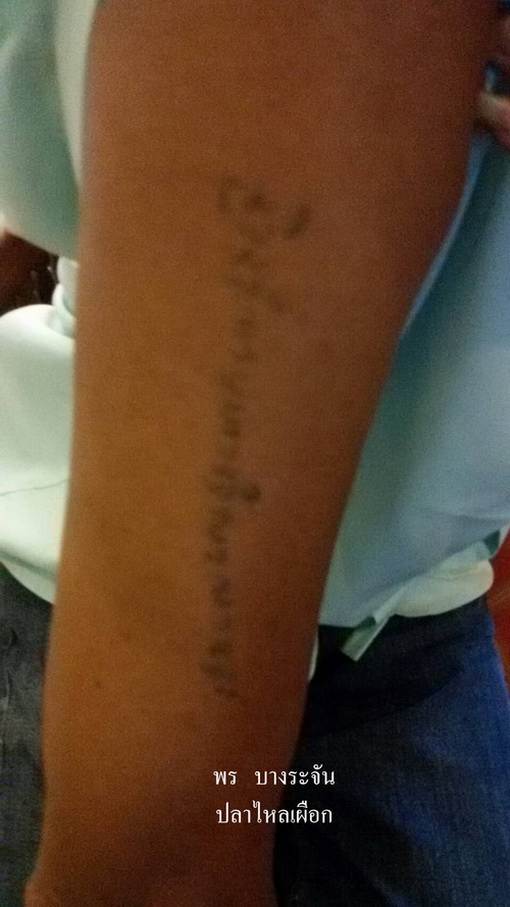 |
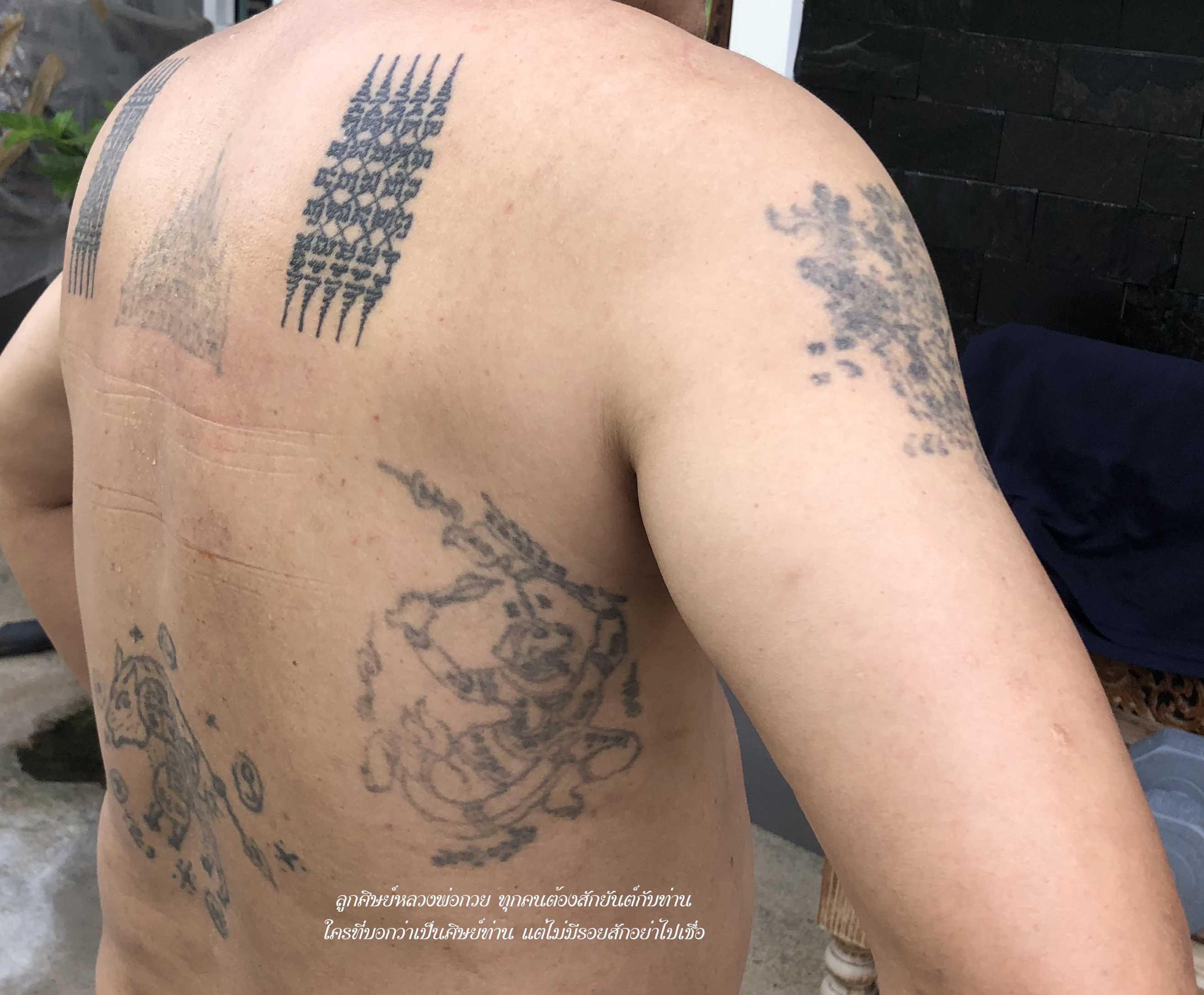 |



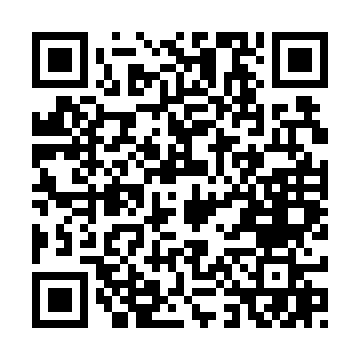
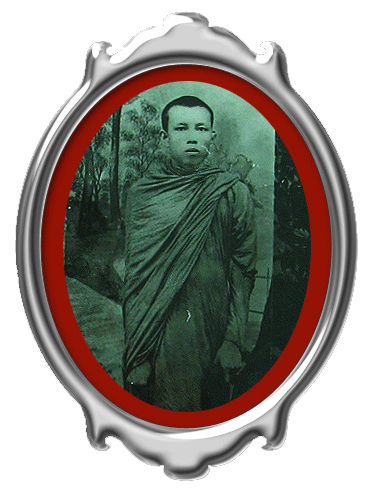
.jpg)


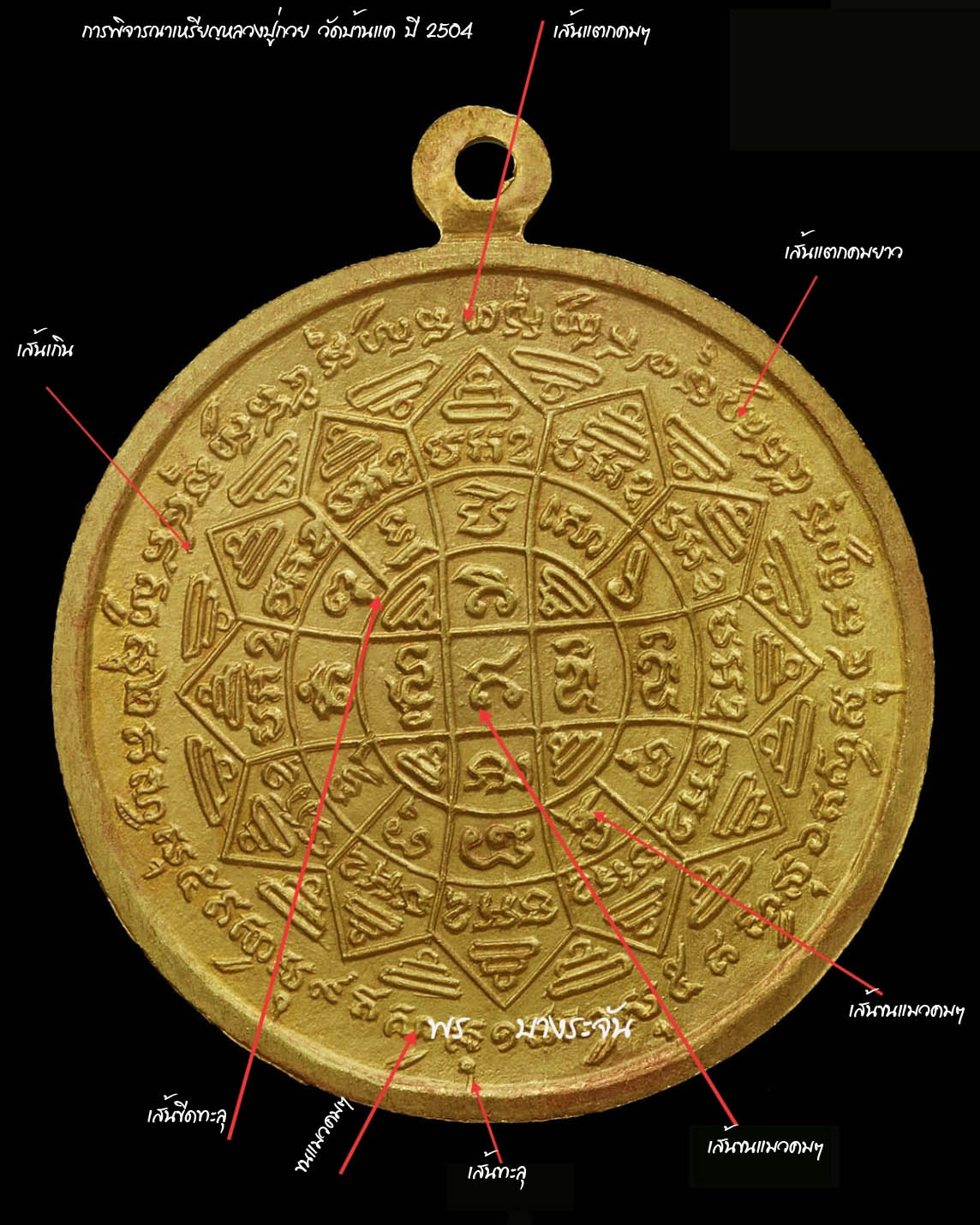
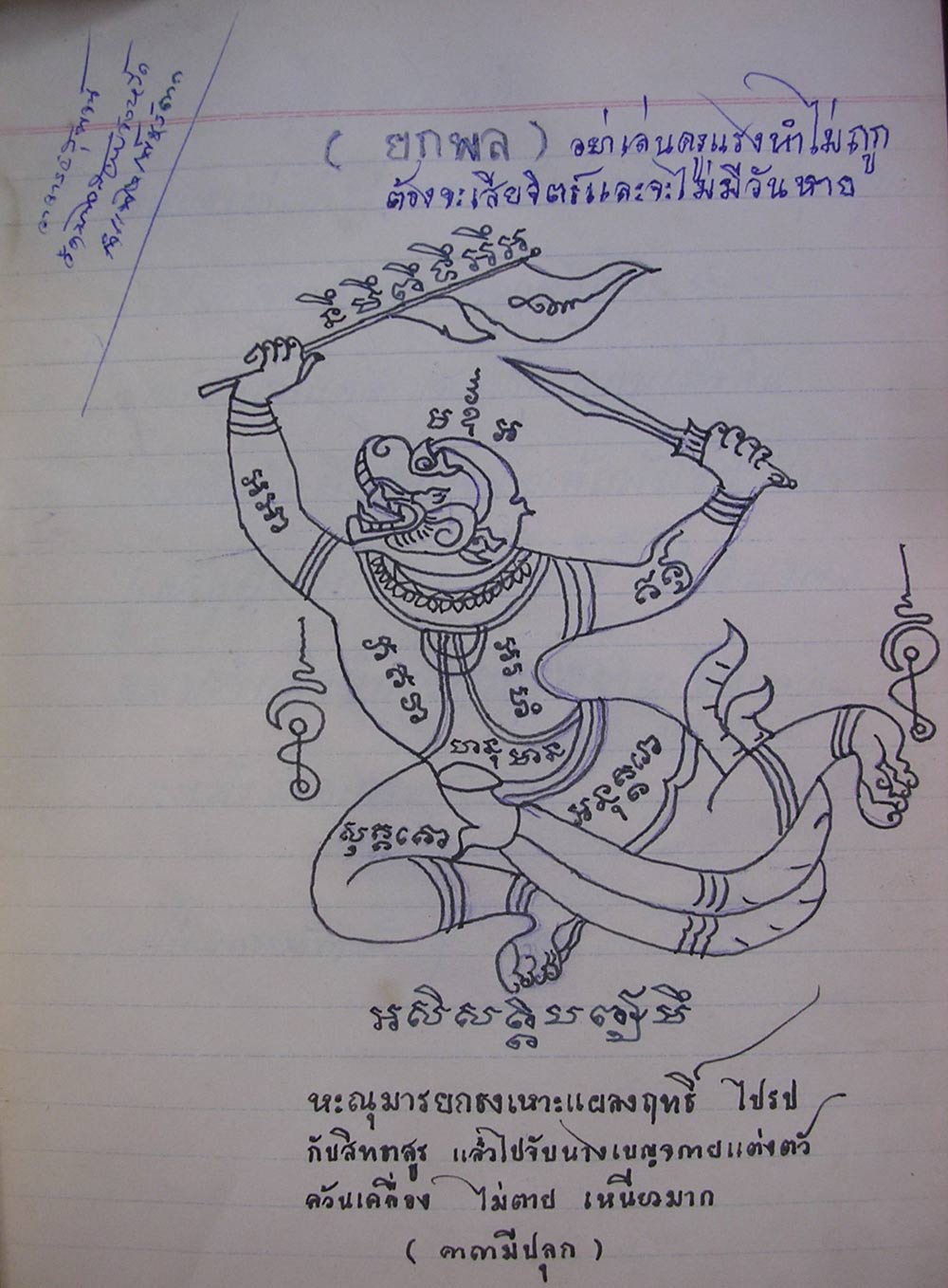
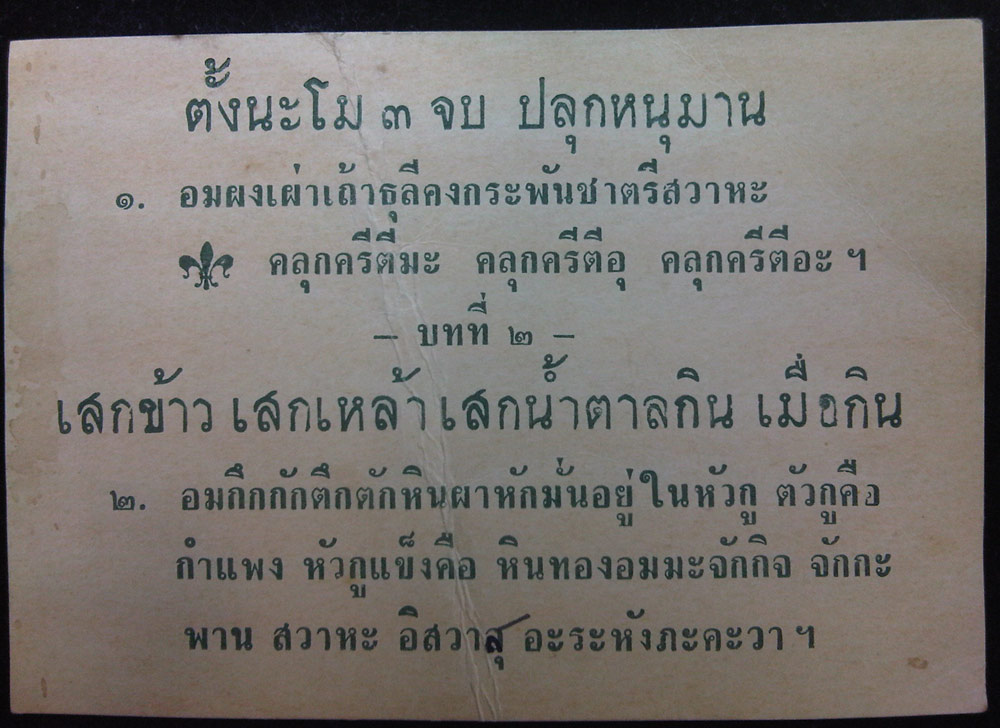

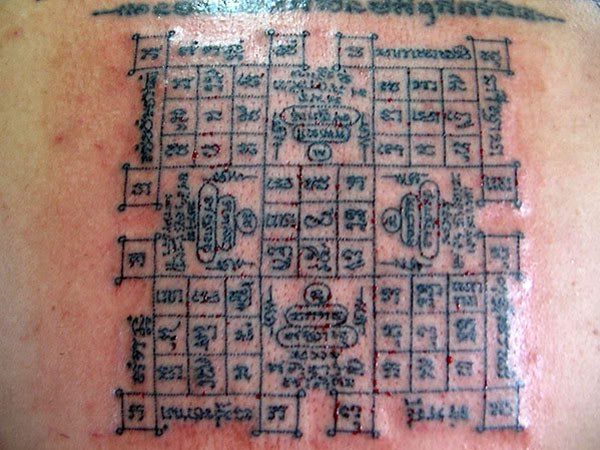
.jpg)

